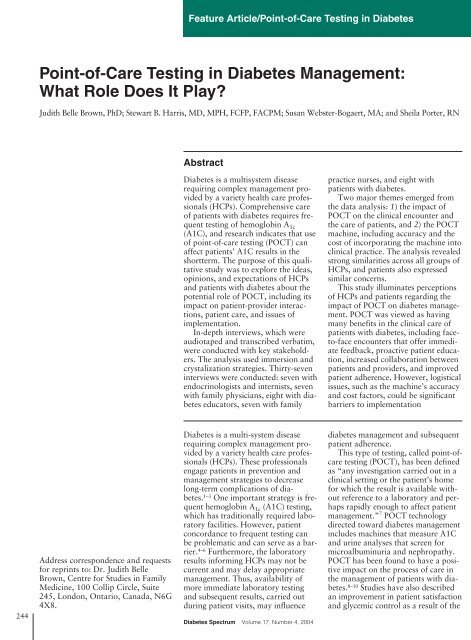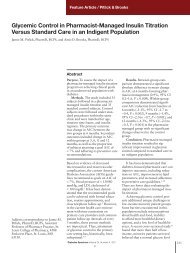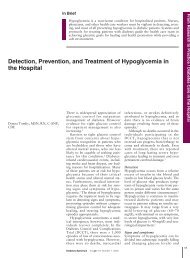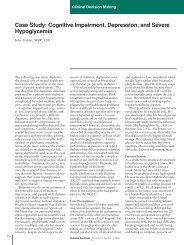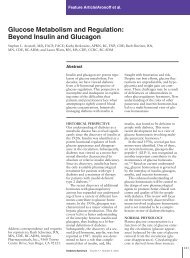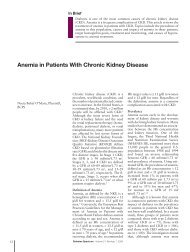Point-of-Care Testing in Diabetes Management: What Role Does It ...
Point-of-Care Testing in Diabetes Management: What Role Does It ...
Point-of-Care Testing in Diabetes Management: What Role Does It ...
Create successful ePaper yourself
Turn your PDF publications into a flip-book with our unique Google optimized e-Paper software.
244<br />
Address correspondence and requests<br />
for repr<strong>in</strong>ts to: Dr. Judith Belle<br />
Brown, Centre for Studies <strong>in</strong> Family<br />
Medic<strong>in</strong>e, 100 Collip Circle, Suite<br />
245, London, Ontario, Canada, N6G<br />
4X8.<br />
Feature Article/<strong>Po<strong>in</strong>t</strong>-<strong>of</strong>-<strong>Care</strong> <strong>Test<strong>in</strong>g</strong> <strong>in</strong> <strong>Diabetes</strong><br />
<strong>Po<strong>in</strong>t</strong>-<strong>of</strong>-<strong>Care</strong> <strong>Test<strong>in</strong>g</strong> <strong>in</strong> <strong>Diabetes</strong> <strong>Management</strong>:<br />
<strong>What</strong> <strong>Role</strong> <strong>Does</strong> <strong>It</strong> Play?<br />
Judith Belle Brown, PhD; Stewart B. Harris, MD, MPH, FCFP, FACPM; Susan Webster-Bogaert, MA; and Sheila Porter, RN<br />
Abstract<br />
<strong>Diabetes</strong> is a multisystem disease<br />
requir<strong>in</strong>g complex management provided<br />
by a variety health care pr<strong>of</strong>essionals<br />
(HCPs). Comprehensive care<br />
<strong>of</strong> patients with diabetes requires frequent<br />
test<strong>in</strong>g <strong>of</strong> hemoglob<strong>in</strong> A 1c<br />
(A1C), and research <strong>in</strong>dicates that use<br />
<strong>of</strong> po<strong>in</strong>t-<strong>of</strong>-care test<strong>in</strong>g (POCT) can<br />
affect patients’ A1C results <strong>in</strong> the<br />
shortterm. The purpose <strong>of</strong> this qualitative<br />
study was to explore the ideas,<br />
op<strong>in</strong>ions, and expectations <strong>of</strong> HCPs<br />
and patients with diabetes about the<br />
potential role <strong>of</strong> POCT, <strong>in</strong>clud<strong>in</strong>g its<br />
impact on patient-provider <strong>in</strong>teractions,<br />
patient care, and issues <strong>of</strong><br />
implementation.<br />
In-depth <strong>in</strong>terviews, which were<br />
audiotaped and transcribed verbatim,<br />
were conducted with key stakeholders.<br />
The analysis used immersion and<br />
crystalization strategies. Thirty-seven<br />
<strong>in</strong>terviews were conducted: seven with<br />
endocr<strong>in</strong>ologists and <strong>in</strong>ternists, seven<br />
with family physicians, eight with diabetes<br />
educators, seven with family<br />
<strong>Diabetes</strong> is a multi-system disease<br />
requir<strong>in</strong>g complex management provided<br />
by a variety health care pr<strong>of</strong>essionals<br />
(HCPs). These pr<strong>of</strong>essionals<br />
engage patients <strong>in</strong> prevention and<br />
management strategies to decrease<br />
long-term complications <strong>of</strong> diabetes.<br />
1–3 One important strategy is frequent<br />
hemoglob<strong>in</strong> A 1c (A1C) test<strong>in</strong>g,<br />
which has traditionally required laboratory<br />
facilities. However, patient<br />
concordance to frequent test<strong>in</strong>g can<br />
be problematic and can serve as a barrier.<br />
4–6 Furthermore, the laboratory<br />
results <strong>in</strong>form<strong>in</strong>g HCPs may not be<br />
current and may delay appropriate<br />
management. Thus, availability <strong>of</strong><br />
more immediate laboratory test<strong>in</strong>g<br />
and subsequent results, carried out<br />
dur<strong>in</strong>g patient visits, may <strong>in</strong>fluence<br />
<strong>Diabetes</strong> Spectrum Volume 17, Number 4, 2004<br />
practice nurses, and eight with<br />
patients with diabetes.<br />
Two major themes emerged from<br />
the data analysis: 1) the impact <strong>of</strong><br />
POCT on the cl<strong>in</strong>ical encounter and<br />
the care <strong>of</strong> patients, and 2) the POCT<br />
mach<strong>in</strong>e, <strong>in</strong>clud<strong>in</strong>g accuracy and the<br />
cost <strong>of</strong> <strong>in</strong>corporat<strong>in</strong>g the mach<strong>in</strong>e <strong>in</strong>to<br />
cl<strong>in</strong>ical practice. The analysis revealed<br />
strong similarities across all groups <strong>of</strong><br />
HCPs, and patients also expressed<br />
similar concerns.<br />
This study illum<strong>in</strong>ates perceptions<br />
<strong>of</strong> HCPs and patients regard<strong>in</strong>g the<br />
impact <strong>of</strong> POCT on diabetes management.<br />
POCT was viewed as hav<strong>in</strong>g<br />
many benefits <strong>in</strong> the cl<strong>in</strong>ical care <strong>of</strong><br />
patients with diabetes, <strong>in</strong>clud<strong>in</strong>g faceto-face<br />
encounters that <strong>of</strong>fer immediate<br />
feedback, proactive patient education,<br />
<strong>in</strong>creased collaboration between<br />
patients and providers, and improved<br />
patient adherence. However, logistical<br />
issues, such as the mach<strong>in</strong>e’s accuracy<br />
and cost factors, could be significant<br />
barriers to implementation<br />
diabetes management and subsequent<br />
patient adherence.<br />
This type <strong>of</strong> test<strong>in</strong>g, called po<strong>in</strong>t-<strong>of</strong>care<br />
test<strong>in</strong>g (POCT), has been def<strong>in</strong>ed<br />
as “any <strong>in</strong>vestigation carried out <strong>in</strong> a<br />
cl<strong>in</strong>ical sett<strong>in</strong>g or the patient’s home<br />
for which the result is available without<br />
reference to a laboratory and perhaps<br />
rapidly enough to affect patient<br />
management.” 7 POCT technology<br />
directed toward diabetes management<br />
<strong>in</strong>cludes mach<strong>in</strong>es that measure A1C<br />
and ur<strong>in</strong>e analyses that screen for<br />
microalbum<strong>in</strong>uria and nephropathy.<br />
POCT has been found to have a positive<br />
impact on the process <strong>of</strong> care <strong>in</strong><br />
the management <strong>of</strong> patients with diabetes.<br />
8–10 Studies have also described<br />
an improvement <strong>in</strong> patient satisfaction<br />
and glycemic control as a result <strong>of</strong> the
immediate feedback <strong>of</strong> POCT. 8,9<br />
There is, however, limited research<br />
reflect<strong>in</strong>g the perspectives <strong>of</strong> HCPs<br />
and people with diabetes regard<strong>in</strong>g<br />
the role <strong>of</strong> POCT on diabetes management<br />
and the potential impact <strong>of</strong><br />
POCT on rout<strong>in</strong>e diabetes care. The<br />
purpose <strong>of</strong> this study was to explore<br />
ideas, op<strong>in</strong>ions, and expectations <strong>of</strong><br />
HCPs and people with diabetes about<br />
the potential role <strong>of</strong> POCT <strong>in</strong> diabetes<br />
management, specifically the impact<br />
<strong>of</strong> POCT on patient-provider <strong>in</strong>teractions<br />
and patient care, as well as<br />
issues <strong>of</strong> implementation.<br />
METHODS<br />
Sampl<strong>in</strong>g and Recruitment<br />
This study used the qualitative<br />
methodology <strong>of</strong> <strong>in</strong>-depth <strong>in</strong>terviews.<br />
Participants were purposefully chosen<br />
from five groups who were potential<br />
users <strong>of</strong> POCT for diabetes. These<br />
<strong>in</strong>cluded endocr<strong>in</strong>ologists, family<br />
physicians, family practice nurses, diabetes<br />
educators, and people with diabetes.<br />
A maximum variation sample<br />
<strong>of</strong> the health care pr<strong>of</strong>essionals was<br />
determ<strong>in</strong>ed by their practice location<br />
(urban/rural), practice size, and academic<br />
affiliation. 11 They were identified<br />
from exist<strong>in</strong>g membership lists or staff<br />
list<strong>in</strong>gs <strong>of</strong> local hospitals <strong>in</strong> southwestern<br />
Ontario, Canada. Potential<br />
participants who had diabetes were<br />
recruited from the local chapter <strong>of</strong> the<br />
Canadian <strong>Diabetes</strong> Association <strong>in</strong><br />
London, Ontario, Canada.<br />
The f<strong>in</strong>al sample size was determ<strong>in</strong>ed<br />
from the cont<strong>in</strong>uous analysis <strong>of</strong><br />
the <strong>in</strong>terviews and ceased once the<br />
researchers agreed they had reached<br />
theme saturation <strong>in</strong> that no new concepts<br />
or ideas were be<strong>in</strong>g <strong>in</strong>troduced<br />
by the participants. 11 Saturation was<br />
achieved <strong>in</strong> all five <strong>of</strong> the potential<br />
user groups listed above. Ethical<br />
approval was received from the ethics<br />
review board for health sciences<br />
research <strong>in</strong>volv<strong>in</strong>g human subjects at<br />
the University <strong>of</strong> Western Ontario.<br />
Data Collection<br />
The semistructured <strong>in</strong>terviews, conducted<br />
primarily <strong>in</strong> participants’<br />
<strong>of</strong>fices or homes, were audiotaped<br />
and lasted ~ 30 m<strong>in</strong>utes. The <strong>in</strong>terviews<br />
were conducted by either the<br />
project coord<strong>in</strong>ator or the research<br />
nurse. Interviewers explored the participants’<br />
ideas, op<strong>in</strong>ions, and expec-<br />
Feature Article/Brown et al.<br />
tations about the potential role <strong>of</strong><br />
POCT <strong>in</strong> diabetes management and<br />
the impact <strong>of</strong> POCT on patientprovider<br />
<strong>in</strong>teractions. For example,<br />
open-ended questions <strong>in</strong>cluded, “How<br />
would access to POCT <strong>in</strong>fluence your<br />
management <strong>of</strong> patients with diabetes?”,<br />
“<strong>What</strong> would be the impact<br />
<strong>of</strong> POCT on the <strong>in</strong>teraction with your<br />
patient?”, and “<strong>What</strong> would be the<br />
impact <strong>of</strong> POCT on your compliance<br />
with physician or nurse recommendations?”<br />
The audiotapes were transcribed<br />
verbatim and transferred <strong>in</strong>to<br />
the NUD*IST qualitative s<strong>of</strong>tware<br />
program. 12<br />
Data Analysis<br />
Immersion and crystallization analysis<br />
strategies were used. 13 This required<br />
that all <strong>of</strong> the researchers (J.B.B.,<br />
S.B.H., S.W.B., and S.P.) read all the<br />
transcripts <strong>in</strong>dependently, identify<strong>in</strong>g<br />
key phrases or concepts used by the<br />
participants dur<strong>in</strong>g the <strong>in</strong>terviews.<br />
They then met to compare and contrast<br />
their <strong>in</strong>dividual f<strong>in</strong>d<strong>in</strong>gs and thus<br />
clarify and expand the themes.<br />
Discussions ensued until consensus<br />
was reached. Next, patterns, categories,<br />
and themes emerg<strong>in</strong>g from the<br />
<strong>in</strong>terviews from each participant<br />
group and across all groups were<br />
exam<strong>in</strong>ed us<strong>in</strong>g the qualitative s<strong>of</strong>tware<br />
program noted above. This<br />
aided <strong>in</strong> clarify<strong>in</strong>g the most prom<strong>in</strong>ent<br />
themes and secur<strong>in</strong>g the most relevant<br />
quotes for illustration. The analysis<br />
was deemed complete when there<br />
were no new themes emerg<strong>in</strong>g, aga<strong>in</strong><br />
based on hav<strong>in</strong>g reached saturation. 11<br />
Authenticity<br />
Credibility <strong>of</strong> the data was established<br />
by audiotap<strong>in</strong>g and transcrib<strong>in</strong>g all <strong>of</strong><br />
the <strong>in</strong>terview data verbatim, ma<strong>in</strong>ta<strong>in</strong><strong>in</strong>g<br />
field notes, and systematic <strong>in</strong>dividual<br />
and team analysis. The multidiscipl<strong>in</strong>ary<br />
composition <strong>of</strong> the research<br />
team also enhanced the credibility <strong>of</strong><br />
the analysis and <strong>in</strong>terpretation <strong>of</strong> the<br />
data.<br />
FINDINGS<br />
A total <strong>of</strong> 37 <strong>in</strong>terviews were conducted.<br />
These <strong>in</strong>cluded <strong>in</strong>terviews with<br />
seven family physicians (four urban<br />
and three rural), five endocr<strong>in</strong>ologists<br />
(five urban), two <strong>in</strong>ternists (one rural,<br />
one urban), eight diabetes educators<br />
(five urban, three rural), seven family<br />
practice nurses (four urban, three<br />
<strong>Diabetes</strong> Spectrum Volume 17, Number 4, 2004<br />
rural), and eight people with diabetes<br />
who all dwelled <strong>in</strong> an urban community.<br />
Two major themes emerged reflect<strong>in</strong>g<br />
the participants’ ideas, op<strong>in</strong>ions,<br />
and expectations about POCT. One<br />
theme was the impact <strong>of</strong> POCT on the<br />
cl<strong>in</strong>ical encounter and the care <strong>of</strong><br />
patients. The other theme was specifically<br />
on the POCT mach<strong>in</strong>e, <strong>in</strong>clud<strong>in</strong>g<br />
accuracy and the cost <strong>of</strong> <strong>in</strong>corporat<strong>in</strong>g<br />
the mach<strong>in</strong>e <strong>in</strong>to cl<strong>in</strong>ical practice. <strong>It</strong><br />
was apparent <strong>in</strong> the analysis that there<br />
were strong similarities across all <strong>of</strong><br />
the HCP groups, and, consequently,<br />
they are reported as a common voice.<br />
While participants who had diabetes<br />
also expressed similar perspectives,<br />
with<strong>in</strong> each subsection reported below<br />
they are reported as a separate group<br />
and are referred to as patients given<br />
the cl<strong>in</strong>ical context.<br />
Impact <strong>of</strong> POCT on Cl<strong>in</strong>ical <strong>Care</strong><br />
All <strong>of</strong> the participants acknowledged<br />
the valuable impact <strong>of</strong> POCT on the<br />
cl<strong>in</strong>ical care <strong>of</strong> patients with type 2<br />
diabetes. The <strong>in</strong>formation provided by<br />
POCT was viewed as immediate, convenient<br />
for all <strong>in</strong>volved, and an aid to<br />
cl<strong>in</strong>ical decisions for diabetes management.<br />
Participants perceived the<br />
receipt <strong>of</strong> the <strong>in</strong>formation <strong>in</strong> a face-t<strong>of</strong>ace<br />
manner as enhanc<strong>in</strong>g the patientprovider<br />
<strong>in</strong>teraction, as characterized<br />
by improved communication, opportunities<br />
for patient education, and<br />
ultimately <strong>in</strong>creased patient adherence.<br />
Further detail on each <strong>of</strong> these<br />
components <strong>of</strong> the cl<strong>in</strong>ical encounter<br />
are described below.<br />
Immediacy <strong>of</strong> results. Participants<br />
endorsed immediacy <strong>of</strong> results as the<br />
greatest advantage <strong>of</strong> POCT and<br />
viewed it as enhanc<strong>in</strong>g cl<strong>in</strong>ical care. A<br />
typical sentiment, as one HCP<br />
expressed it, was that, “Immediate<br />
answers are <strong>in</strong>credibly important to<br />
patients these days . . . so it is sometimes<br />
not acceptable for them to wait<br />
3–4 weeks to get a result <strong>of</strong> a microalbum<strong>in</strong>.”<br />
Participants said that the immediate<br />
results allowed HCPs to “strike<br />
while the iron is hot” and to “decide<br />
on a management change potentially<br />
right then and there.” Be<strong>in</strong>g able to<br />
recommend specific changes was perceived<br />
as more efficient and thorough.<br />
“<strong>It</strong> makes the process more efficient <strong>in</strong><br />
terms <strong>of</strong> recommendations you’re<br />
go<strong>in</strong>g to make to the person and to<br />
245
246<br />
check on how they’re tak<strong>in</strong>g care <strong>of</strong><br />
their problems.”<br />
From the patients’ perspective, the<br />
immediacy <strong>of</strong> POCT had many benefits.<br />
As one patient noted, “If I have<br />
any problems, or if I have any questions<br />
from the results, I can discuss it<br />
with him right away and it saves me<br />
time, saves me the anxiety <strong>of</strong> wait<strong>in</strong>g,<br />
and he also can take action right<br />
away.”<br />
Information shared dur<strong>in</strong>g the<br />
cl<strong>in</strong>ical encounter. HCP participants<br />
perceived another benefit <strong>of</strong> the<br />
immediacy <strong>of</strong> POCT as be<strong>in</strong>g the<br />
exchange <strong>of</strong> <strong>in</strong>formation <strong>in</strong> a face-t<strong>of</strong>ace<br />
encounter with patients. This<br />
was preferred over a telephone<br />
exchange and viewed as hav<strong>in</strong>g more<br />
impact. As one participant noted, “I<br />
th<strong>in</strong>k that it would save time, you<br />
would be able to address it right then<br />
and there with the patient <strong>in</strong> person.<br />
Which I th<strong>in</strong>k carries a different<br />
weight than hav<strong>in</strong>g it over the<br />
phone.” Patients agreed. “I th<strong>in</strong>k it<br />
delivers more punch . . . and you can<br />
problem-solve and troubleshoot.”<br />
Information could be shared<br />
between patients and providers, therefore<br />
enhanc<strong>in</strong>g the dialogue between<br />
them and clarify<strong>in</strong>g patients’ understand<strong>in</strong>g<br />
and further concerns. As one<br />
family practice nurse stated, “If you’re<br />
tak<strong>in</strong>g the time to expla<strong>in</strong> test results<br />
that are immediate like this, I th<strong>in</strong>k<br />
the patients then feel comfortable <strong>in</strong><br />
ask<strong>in</strong>g you further questions, which<br />
can help you establish whether or not<br />
they’re understand<strong>in</strong>g what you’re<br />
tell<strong>in</strong>g them, but also evaluate what<br />
direction you need to go with them.”<br />
In addition it could also assist cl<strong>in</strong>icians<br />
<strong>in</strong> determ<strong>in</strong><strong>in</strong>g the most appropriate<br />
care plan, enhanc<strong>in</strong>g patients’<br />
ability for self-care. Said one HCP<br />
participant, “I th<strong>in</strong>k it gives you better<br />
ability to sort <strong>of</strong> focus the care and<br />
empower the patient with giv<strong>in</strong>g them<br />
<strong>in</strong>formation and numbers, and so that<br />
they know what is go<strong>in</strong>g on with their<br />
own diabetes.”<br />
Patient education and patient<br />
adherence. There were strong l<strong>in</strong>ks<br />
between the immediacy provided by<br />
POCT, face-to-face communication,<br />
and the opportunity for relevant and<br />
proactive patient education. This was<br />
most frequently mentioned by nurses<br />
and dietitian educators, <strong>in</strong>clud<strong>in</strong>g one<br />
who praised “the motivational aspect<br />
and mov<strong>in</strong>g patients along. Quite<br />
Feature Article/<strong>Po<strong>in</strong>t</strong>-<strong>of</strong>-<strong>Care</strong> <strong>Test<strong>in</strong>g</strong> <strong>in</strong> <strong>Diabetes</strong><br />
<strong>of</strong>ten, they forget, and so you have to<br />
then turn around and reiterate and<br />
re<strong>in</strong>force. Sometimes, hav<strong>in</strong>g that<br />
piece <strong>of</strong> <strong>in</strong>formation right then and<br />
there, you can say ‘OK, this is where<br />
we are at, and we need to move<br />
along.’”<br />
Participants described the face-t<strong>of</strong>ace<br />
feedback and opportunities for<br />
education as affect<strong>in</strong>g patient adherence<br />
with the management regimen.<br />
Said one, “Well, if you believe the<br />
quality <strong>of</strong> the <strong>in</strong>teraction is better,<br />
then I would say the fall-out would be<br />
the compliance benefit.” An outcome<br />
<strong>of</strong> a face-to-face discussion with an<br />
HCP about the POCT results could<br />
assist patients <strong>in</strong> modify<strong>in</strong>g their own<br />
care and tak<strong>in</strong>g personal responsibility.<br />
Said another patient, “I th<strong>in</strong>k it<br />
would have a very direct impact,<br />
because it gives you a picture <strong>of</strong> where<br />
th<strong>in</strong>gs stand right at that very<br />
moment, and you can take corrective<br />
action <strong>in</strong> terms <strong>of</strong> what you are<br />
do<strong>in</strong>g.”<br />
Thus, through the face-to-face discussion<br />
<strong>of</strong> the POCT results, patient<br />
motivation and adherence would be<br />
enhanced, further strengthen<strong>in</strong>g the<br />
collaborative work<strong>in</strong>g relationship<br />
between patients and their HCPs.<br />
“You’ve got the cl<strong>in</strong>ical results right<br />
<strong>in</strong> front <strong>of</strong> you, but that’s just a stepp<strong>in</strong>g<br />
stone,” said one HCP participant.<br />
“. . . it gives the opportunity for<br />
the patient to relate to how those cl<strong>in</strong>ical<br />
tests are actually go<strong>in</strong>g to impact<br />
on their care. . . . I th<strong>in</strong>k patients then<br />
feel comfortable <strong>in</strong> ask<strong>in</strong>g you further<br />
questions.”<br />
Patients confirmed this perspective.<br />
“So, I th<strong>in</strong>k that it would def<strong>in</strong>itely<br />
help the discussion with your family<br />
physician,” one noted. And another<br />
patient stated, “You have to face the<br />
music. Whereas when you go to the<br />
lab later and you get the results over<br />
the phone, it doesn’t have the impact<br />
that it does when you’re sitt<strong>in</strong>g <strong>in</strong> the<br />
<strong>of</strong>fice, and your physician beg<strong>in</strong>s to<br />
shake his f<strong>in</strong>ger at you or whatever it<br />
is that he or she needs to do to get<br />
you motivated. I th<strong>in</strong>k it makes a big<br />
difference.”<br />
Accuracy and Cost: Barriers to<br />
Implementation<br />
As noted above, all participants<br />
believed that POCT had an important<br />
role to play <strong>in</strong> diabetes management.<br />
However, the potential barriers to the<br />
<strong>Diabetes</strong> Spectrum Volume 17, Number 4, 2004<br />
implementation <strong>of</strong> POCT, namely,<br />
accuracy <strong>of</strong> the mach<strong>in</strong>e and cost,<br />
were another pervasive theme<br />
throughout the <strong>in</strong>terviews.<br />
Accuracy. The primary concern<br />
articulated by most HCPs was the<br />
accuracy <strong>of</strong> the mach<strong>in</strong>e provid<strong>in</strong>g the<br />
POCT. “Accuracy is really important<br />
and confidence that it is accurate,”<br />
said one. In order to ensure accuracy,<br />
quality control was seen as important,<br />
<strong>in</strong>clud<strong>in</strong>g tra<strong>in</strong><strong>in</strong>g <strong>of</strong> personnel who<br />
would be rout<strong>in</strong>ely us<strong>in</strong>g the POCT.<br />
Patients also emphasized the<br />
importance <strong>of</strong> accurate results. When<br />
assured <strong>of</strong> the accuracy <strong>of</strong> POCT, all<br />
participants endorsed the application<br />
<strong>of</strong> POCT technology. “As long as it is<br />
accurate,” one patient said, “ . . . then<br />
I th<strong>in</strong>k it could be a very valuable tool<br />
for all health care pr<strong>of</strong>essionals.”<br />
Cost. The issue <strong>of</strong> cost was at the<br />
core <strong>of</strong> the logistical concerns regard<strong>in</strong>g<br />
POCT that would ultimately dictate<br />
decisions regard<strong>in</strong>g implementation<br />
<strong>of</strong> the technology. Personnel<br />
issues were raised by all. Participants<br />
identified concerns regard<strong>in</strong>g the costs<br />
associated with staff tra<strong>in</strong><strong>in</strong>g. “How<br />
much tra<strong>in</strong><strong>in</strong>g do you need to be able<br />
to use this?” one asked. Also, the cost<br />
associated with staff perform<strong>in</strong>g extra<br />
duties could be a potential barrier. As<br />
one physician noted, “<strong>It</strong> would be a<br />
task delegated to the nurse, but it<br />
would impact <strong>in</strong>directly on my time<br />
by the amount <strong>of</strong> additional time that<br />
the nurse uses.”<br />
Concerns about the logistics <strong>of</strong><br />
implement<strong>in</strong>g POCT also <strong>in</strong>cluded<br />
issues regard<strong>in</strong>g the physical space<br />
necessary, <strong>in</strong> particular the cost associated<br />
with changes or renovations.<br />
One participant noted that “. . . there<br />
would be an issue <strong>of</strong> where to locate it<br />
so it’s accessible to a lot <strong>of</strong> people.”<br />
Participants believed that the cost concerns<br />
would also be determ<strong>in</strong>ed by the<br />
location <strong>of</strong> HCPs’ practice. “In my<br />
sett<strong>in</strong>g, I would assume that’s a hospital<br />
budget issue, and <strong>in</strong> the family<br />
doctor’s <strong>of</strong>fice, that’s a much more<br />
personal issue,” one participant<br />
noted. Even participants work<strong>in</strong>g <strong>in</strong> a<br />
hospital questioned which hospital<br />
department budget would be responsible<br />
for the cost <strong>of</strong> POCT. “The cost is<br />
a drawback,” said one. “And I don’t<br />
know whose budget these would<br />
come under.”<br />
The cost, therefore, could be a<br />
major deterrent to the implementation
<strong>of</strong> POCT. As one participant summed<br />
it up, “Who’s go<strong>in</strong>g to cover the cost<br />
<strong>of</strong> this? . . . <strong>It</strong>’s not so much the equipment<br />
<strong>in</strong> the first place, but to keep the<br />
sticks on hand to be used on patients<br />
can be costly, and if that’s not covered,<br />
then why would a physician do<br />
it this way? Why wouldn’t they send<br />
the work out to a lab?”<br />
If these f<strong>in</strong>ancial issues could be<br />
resolved, participants believed that<br />
POCT would promote an efficient use<br />
<strong>of</strong> time and would therefore be cost<br />
sav<strong>in</strong>g. For example, some physicians<br />
justified the expenditure <strong>of</strong> <strong>in</strong>creased<br />
time by themselves and their staff at<br />
the outset as potentially sav<strong>in</strong>g time <strong>in</strong><br />
the future. “<strong>It</strong> would <strong>in</strong>crease the<br />
length <strong>of</strong> a patient visit, but it would<br />
decrease the phone calls and staff time<br />
later on.” Many participants justified<br />
the extra time required as possibly<br />
time sav<strong>in</strong>g. “If you compare it to<br />
hav<strong>in</strong>g to follow-up a week, two<br />
weeks, a month later with results, I<br />
th<strong>in</strong>k ultimately it would save you<br />
time.” Patients also perceived a costsav<strong>in</strong>g<br />
potential. “If this could be<br />
done <strong>in</strong> the doctor’s <strong>of</strong>fice, the<br />
amount <strong>of</strong> money it would save <strong>in</strong> the<br />
health care system is phenomenal.”<br />
DISCUSSION<br />
This study provides unique <strong>in</strong>sights<br />
<strong>in</strong>to how POCT may change and<br />
enhance the cl<strong>in</strong>ical encounter and<br />
thus improve patient management.<br />
Furthermore, the study f<strong>in</strong>d<strong>in</strong>gs identify<br />
barriers to implementation, <strong>in</strong><br />
particular the cost <strong>of</strong> POCT.<br />
Immediacy and convenience were<br />
viewed as important benefits <strong>of</strong><br />
POCT. Be<strong>in</strong>g able to provide and discuss<br />
the results face-to-face rather<br />
than over the telephone was felt to<br />
have more <strong>of</strong> an impact on patients. <strong>It</strong><br />
also allowed HPCs to recommend<br />
changes <strong>in</strong> management at that visit.<br />
Furthermore, the opportunity to provide<br />
test results immediately, <strong>in</strong> a faceto-face<br />
encounter, was perceived by<br />
participants as promot<strong>in</strong>g shared decision<br />
mak<strong>in</strong>g.<br />
More than a decade ago, Kaplan et<br />
al. 14 produced compell<strong>in</strong>g evidence<br />
about the impact <strong>of</strong> <strong>in</strong>formation shar<strong>in</strong>g<br />
and active patient participation<br />
dur<strong>in</strong>g patient-doctor <strong>in</strong>teractions on<br />
patient health outcomes. A more<br />
recent study by Little et al. 15 found<br />
that patients expect communication<br />
with their physician to <strong>in</strong>clude <strong>in</strong>for-<br />
Feature Article/Brown et al.<br />
mation shar<strong>in</strong>g and expect to be<br />
engaged as a partner <strong>in</strong> their care.<br />
Our f<strong>in</strong>d<strong>in</strong>gs reflect<strong>in</strong>g the views <strong>of</strong><br />
multiple HCPs and patients endorse<br />
this prior research.<br />
Perhaps most importantly, our participants<br />
viewed POCT as an opportunity<br />
to capitalize on patient education.<br />
As Price 16 stated, POCT “will be beneficial<br />
only if appropriate action is<br />
taken on the result.” Therefore, it<br />
may not be sufficient to simply report<br />
results to the patient; that must be<br />
accompanied by comprehensive diabetes<br />
management that motivates<br />
patients to assume a greater level <strong>of</strong><br />
self-care.<br />
Participants’ expectations that<br />
POCT would positively impact patient<br />
outcomes, such as adherence and<br />
immediate adjustments to hyperglycemia<br />
management, have been<br />
found <strong>in</strong> prior research. 8–10 Participants<br />
generally viewed POCT as a potential<br />
time saver (i.e., fewer telephone contacts<br />
and return visits), although this<br />
has not been found <strong>in</strong> prior research. 9<br />
Although our participants strongly<br />
endorsed the value and advantages <strong>of</strong><br />
POCT, logistical factors could still<br />
prevent the implementation <strong>of</strong> this<br />
technology. Our f<strong>in</strong>d<strong>in</strong>gs revealed<br />
concerns about accuracy as be<strong>in</strong>g<br />
foundational to any discussion <strong>of</strong><br />
us<strong>in</strong>g POCT. F<strong>in</strong>ancial issues were the<br />
other pr<strong>in</strong>cipal concern <strong>of</strong> the participants<br />
and dom<strong>in</strong>ated the discussion.<br />
Costs associated with POCT have<br />
been noted previously. 16,17 Participants’<br />
concerns reiterated observations made<br />
by Delaney et al., 18 who observed that<br />
without evidence to support the cost<br />
effectiveness <strong>of</strong> POCT, the implementation<br />
<strong>of</strong> this technology <strong>in</strong> primary<br />
health care sett<strong>in</strong>gs would be low. A<br />
review by Baer 19 <strong>of</strong> the cost <strong>of</strong> POCT<br />
versus perform<strong>in</strong>g the same tests <strong>in</strong> laboratories<br />
found that approximately<br />
half <strong>of</strong> the studies reported POCT as<br />
be<strong>in</strong>g less expensive. Even when consider<strong>in</strong>g<br />
the cost <strong>of</strong> POCT <strong>in</strong> the hospital<br />
sett<strong>in</strong>g, there is contradictory evidence.<br />
17,20 Dolega 21 has called for outcome<br />
studies to balance the cost <strong>of</strong><br />
POCT with medical need, doctor and<br />
patient preference, and the effect on<br />
total health care costs.<br />
Hence, cost may be the driv<strong>in</strong>g force<br />
beh<strong>in</strong>d the implementation <strong>of</strong> POCT.<br />
Rapid advancements <strong>in</strong> POCT technology<br />
may elim<strong>in</strong>ate many <strong>of</strong> the logistical<br />
concerns, such as space require-<br />
<strong>Diabetes</strong> Spectrum Volume 17, Number 4, 2004<br />
ments and accuracy. But until issues <strong>of</strong><br />
remuneration are addressed, specifically<br />
for community-based practitioners,<br />
the cost will rema<strong>in</strong> a concern, and<br />
implementation will be stalled.<br />
CONCLUSIONS<br />
Hav<strong>in</strong>g access to immediate results<br />
can help improve HCPs’ communication<br />
and collaboration <strong>in</strong> the management<br />
<strong>of</strong> their patients with diabetes.<br />
This <strong>in</strong>formation promotes face-t<strong>of</strong>ace<br />
communication not only between<br />
patients and providers but also among<br />
HPCs. Furthermore, patient education<br />
efforts can be coord<strong>in</strong>ated and re<strong>in</strong>forced<br />
by all HCPs work<strong>in</strong>g with a<br />
given patient.<br />
Participants viewed the ability to<br />
accelerate the cl<strong>in</strong>ical decision-mak<strong>in</strong>g<br />
process, specifically at the time <strong>of</strong> the<br />
patient visit, as an important aspect <strong>of</strong><br />
POCT <strong>in</strong> diabetes management, and<br />
this is supported by prior research. 22<br />
This also re<strong>in</strong>forces patient-centered<br />
practice, which encourages management<br />
decisions to be specific to patient<br />
needs, promote partnerships between<br />
both patients and HPCs, allow opportunities<br />
for prevention and health promotion,<br />
and enhance patient-HPC<br />
<strong>in</strong>teractions through improved communication<br />
and f<strong>in</strong>d<strong>in</strong>g common<br />
ground regard<strong>in</strong>g management. 23,24<br />
Patient education will then transpire<br />
with<strong>in</strong> an <strong>in</strong>teraction between patients<br />
and HPCs that promotes self-care<br />
behavior.<br />
Acknowledgment<br />
Bayer Corp. provided funds to support<br />
this research through an unrestricted<br />
research grant.<br />
References<br />
1 U.K. Prospective <strong>Diabetes</strong> Study Group:<br />
Intensive blood-glucose control with sulphonylureas<br />
or <strong>in</strong>sul<strong>in</strong> compared with conventional<br />
treatment and risk <strong>of</strong> complications <strong>in</strong> patients<br />
with type 2 diabetes (UKPDS 33). Lancet<br />
352:837–853, 1998<br />
2 U.K. Prospective <strong>Diabetes</strong> Study Group:<br />
Efficacy <strong>of</strong> atenolol and captopril <strong>in</strong> reduc<strong>in</strong>g<br />
risk <strong>of</strong> macrovascular and microvascular complications<br />
<strong>in</strong> type 2 diabetes (UKPDS 39). BMJ<br />
317:713–720, 1998<br />
3 U.K. Prospective <strong>Diabetes</strong> Study Group: Tight<br />
blood pressure control and risk <strong>of</strong> macrovascular<br />
and microvascular complications <strong>in</strong> type 2 diabetes<br />
(UKPDS 38). BMJ 317:703–713, 1998<br />
4 Slocum W, Ziemer DC, Culler SD, Cook CB,<br />
Ferguson SY: Poor appo<strong>in</strong>tment keep<strong>in</strong>g behav-<br />
247
248<br />
ior worsens glycemic control (Abstract). <strong>Diabetes</strong><br />
48:A197, 1999<br />
5 Kern DH, Ma<strong>in</strong>ous AG III: Disease management<br />
for diabetes among family physicians and<br />
general <strong>in</strong>ternists: opportunism or planned care?<br />
Fam Med 33:621–625, 2001<br />
6 Brown JB, Harris SB, Webster-Bogaert MS,<br />
Wetmore S, Faulds C, Stewart M: The role <strong>of</strong><br />
patient, physician and systemic factors <strong>in</strong> the<br />
management <strong>of</strong> type 2 diabetes mellitus. Fam<br />
Pract 19:344–349, 2002<br />
7 Hobbs R: Near patient test<strong>in</strong>g <strong>in</strong> primary care.<br />
BMJ 312:263–264, 1996<br />
8 Grieve R, Beech R, V<strong>in</strong>cent J, Mazurkiewicz J:<br />
Near patient test<strong>in</strong>g <strong>in</strong> diabetes cl<strong>in</strong>ics: apprais<strong>in</strong>g<br />
the costs and outcomes. Health Technol<br />
Assess 3:1–74, 1999<br />
9 Cagliero E, Lev<strong>in</strong>a EV, Nathan DM: Immediate<br />
feedback <strong>of</strong> HbA1c levels improves glycemic<br />
control <strong>in</strong> type 1 and <strong>in</strong>sul<strong>in</strong>-treated type 2 diabetic<br />
patients. <strong>Diabetes</strong> <strong>Care</strong> 22:1785–1789,<br />
1999<br />
10 Miller CD, Barnes CS, Phillips LS, Ziemer DC,<br />
Gall<strong>in</strong>a DL, Cook CB, Maryman S, el Kebbi IM:<br />
Rapid A1c availablity improves cl<strong>in</strong>ical decisionmak<strong>in</strong>g<br />
<strong>in</strong> an urban primary care cl<strong>in</strong>ic. <strong>Diabetes</strong><br />
<strong>Care</strong> 26:1158–1163, 2003<br />
11 Patton MQ: Qualitative Research &<br />
Evaluation, 3rd ed. Thousand Oaks, Calif., Sage<br />
Publication, 2002<br />
12 Qualitative Solutions and Research: QSR<br />
NUD*IST 4 User Guide. S<strong>of</strong>tware for<br />
Qualitative Data Analysis. London, Sage<br />
Publications, 1997<br />
Feature Article/<strong>Po<strong>in</strong>t</strong>-<strong>of</strong>-<strong>Care</strong> <strong>Test<strong>in</strong>g</strong> <strong>in</strong> <strong>Diabetes</strong><br />
13 Crabtree BF, Miller WL, Aita VA, Flocke SA,<br />
Stange KC: Primary care practice organization<br />
and preventive services delivery: a qualitative<br />
analysis. J Fam Pract 46:403–409, 1998<br />
14 Kaplan SH, Greenfield S, Ware JE Jr.:<br />
Assess<strong>in</strong>g the effects <strong>of</strong> physician-patient <strong>in</strong>teractions<br />
on the outcomes <strong>of</strong> chronic disease. Med<br />
<strong>Care</strong> 27:S110–S127, 1989<br />
15 Little P, Everitt H, Williamson I, Warner G,<br />
Moore M, Gould C, Ferrier K, Payne S:<br />
Preferences <strong>of</strong> patients for patient centred<br />
approach to consultation <strong>in</strong> primary care: observational<br />
study. BMJ 322:468–472, 2001<br />
16 Price CP: <strong>Po<strong>in</strong>t</strong> <strong>of</strong> care test<strong>in</strong>g. BMJ<br />
322:1285–1288, 2001<br />
17 Miller CM, Niznik C, Spr<strong>in</strong>ger J, Pauly S:<br />
Decentralized lab test<strong>in</strong>g: a collaborative<br />
approach to po<strong>in</strong>t <strong>of</strong> care test<strong>in</strong>g. Hosp Top<br />
73:23–27, 1995<br />
18 Delaney BC, Hyde CJ, McManus RJ, Wilson S,<br />
Fitzmaurice DA, Jowett S, Tobias R, Thorpe<br />
GH, Hobbs R: Systematic review <strong>of</strong> near patient<br />
test evaluations <strong>in</strong> primary care. BMJ<br />
319:824–827, 1999<br />
19 Baer DM: <strong>Po<strong>in</strong>t</strong>-<strong>of</strong>-care test<strong>in</strong>g versus central<br />
lab costs. Med Lab Observ September 1998, p.<br />
6–56<br />
20 Unw<strong>in</strong> N, Thomson R, O’Byrne AM, Laker M,<br />
Armstrong H: Implications <strong>of</strong> apply<strong>in</strong>g widely<br />
accepted cholesterol screen<strong>in</strong>g and management<br />
guidel<strong>in</strong>es to a British adult population: cross<br />
sectional study <strong>of</strong> cardiovascular disease and risk<br />
factors. BMJ 317:1125–1130, 1998<br />
21 Dolega R: Current status <strong>of</strong> hemoglob<strong>in</strong> A1c<br />
<strong>Diabetes</strong> Spectrum Volume 17, Number 4, 2004<br />
test<strong>in</strong>g and applications for test<strong>in</strong>g at the po<strong>in</strong>t <strong>of</strong><br />
care. Diagnost Endocr<strong>in</strong>ol, Immunol Metab<br />
17:99–100, 1999<br />
22 Kendall J, Reeves B, Clancy M: <strong>Po<strong>in</strong>t</strong> <strong>of</strong> care<br />
test<strong>in</strong>g: randomised controlled trial <strong>of</strong> cl<strong>in</strong>ical<br />
outcome. BMJ 316:1052–1057, 1998<br />
23 Stewart M, Brown JB, Weston WW,<br />
McWh<strong>in</strong>ney IR, McWilliam CL, Freeman TR:<br />
Patient-Centered Medic<strong>in</strong>e: Transform<strong>in</strong>g the<br />
Cl<strong>in</strong>ical Method. Thousand Oaks, Calif., Sage<br />
Publications, 1995<br />
24 Brown JB, Stewart M, Weston WW: Patient-<br />
Centered <strong>Care</strong>: Challenges and Solutions <strong>in</strong><br />
Patient-Centered <strong>Care</strong>: A Case Book. Oxford,<br />
U.K., Radcliffe, 2002<br />
Judith Belle Brown, PhD, is a pr<strong>of</strong>essor;<br />
Stewart B. Harris, MD, MPH,<br />
FCFP, FACPM, is an associate pr<strong>of</strong>essor;<br />
Susan Webster-Boagert, MA, is a<br />
project coord<strong>in</strong>ator; and Sheila<br />
Porter, RN, is a research assistant <strong>in</strong><br />
the Department <strong>of</strong> Family Medic<strong>in</strong>e,<br />
Centre for Studies <strong>in</strong> Family Medic<strong>in</strong>e,<br />
<strong>of</strong> the University <strong>of</strong> Western Ontario<br />
<strong>in</strong> London, Ontario, Canada.<br />
Note <strong>of</strong> disclosure: Dr. Harris has<br />
received honoraria for speak<strong>in</strong>g<br />
engagements and research support<br />
from Bayer Health <strong>Care</strong> Inc., which<br />
manufactures POCT devices for diabetes<br />
care.


